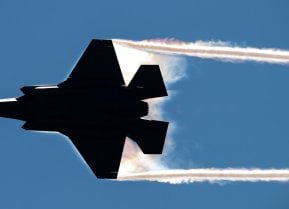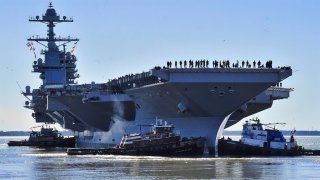The U.S. Navy Is An Aircraft Carrier Superpower No Nation Can Match
When it comes to naval power, aircraft carriers are at the top of the food pile. Essentially floating cities, aircraft carriers can project power and foreign policy like nothing else.
When it comes to naval power, aircraft carriers are at the top of the food pile. Essentially floating cities, aircraft carriers can project power and foreign policy like nothing else.
The Size of the Aircraft Carrier Fleet
Right now, the Navy operates 11 aircraft carriers (ten Nimitz-class carriers and one Ford-class carrier), all of which are nuclear-powered (the Navy decommissioned its last conventionally-powered carrier in 2009.
The number 11 isn’t random. By law, the Navy needs to have a fleet of no less than 11 aircraft carriers at all times (it used to be 12, but the law got amended; also, for a few years, it dropped to 10, and the Navy had to get a temporary waiver from Congress).
Of course, that doesn’t mean all 11 warships must be at sea at the same time. Rather, when Congress enacted that specific law, it wanted to ensure that the U.S. military had a robust carrier capability that could cover multiple areas of operations at the same time.
As a world power, the U.S. is often required to respond to more than one contingency, and aircraft carriers are often the first piece of American warfighting to arrive in a crisis.
In 2016, the Navy released its goals of a 355-ship fleet that would include 12 aircraft carriers. However, that strategic planning didn’t last long, and for the past few years, the Navy has been trying to come up with a new fleet structure. There have been several proposals and research papers on what the ideal fleet structure would be. When it comes to aircraft carriers, the proposals have ranged from eight to 12 nuclear-powered aircraft carriers.
Since law currently requires 11 flattops at all times, in the event the Navy opted to go with a fleet structure of, let’s say, eight carriers, it would have to supplement them with light aircraft carriers.
Building a new aircraft carrier—it is, after all, a floating city with more than 5,000 sailors and marines and dozens of aircraft—is a complex business that requires years of planning and has a lot of moving parts. For the past 60 years, American aircraft carriers have been built in Virginia shipyards. Today, the manufacturing of an aircraft carrier involves as many as 2,000 suppliers from 46 states.
The Ford-Class Aircraft Carrier
The newest class of flattop in the Navy is the Ford-class.
The Ford-class brings several new capabilities to the fleet. The most important piece of technology in the new class is the electromagnetic aircraft launch system, or EMALS, which can launch aircraft at a faster pace. This is an important feature in the context of near-peer warfare as it enables rapid response.

Besides the additional operational capabilities, the Ford-class carriers will be more efficient and thus cheaper to operate.
With several new features, Ford-class flattops will require fewer sailors to operate. Over their projected 50-year lifecycle, Ford-class carriers are expected to cost $4 billion less than their Nimitz-class counterparts.

As of 2024, the Navy has ordered four Ford-class carriers as of 2024.
About the Author
Stavros Atlamazoglou is a seasoned defense journalist specializing in special operations and a Hellenic Army veteran (national service with the 575th Marine Battalion and Army HQ). He holds a BA from Johns Hopkins University and an MA from the Johns Hopkins School of Advanced International Studies (SAIS). His work has been featured in Business Insider, Sandboxx, and SOFREP. Email the author: [email protected].


